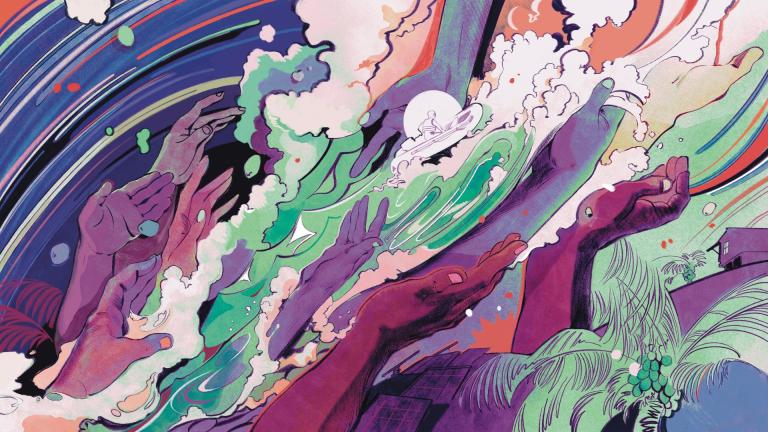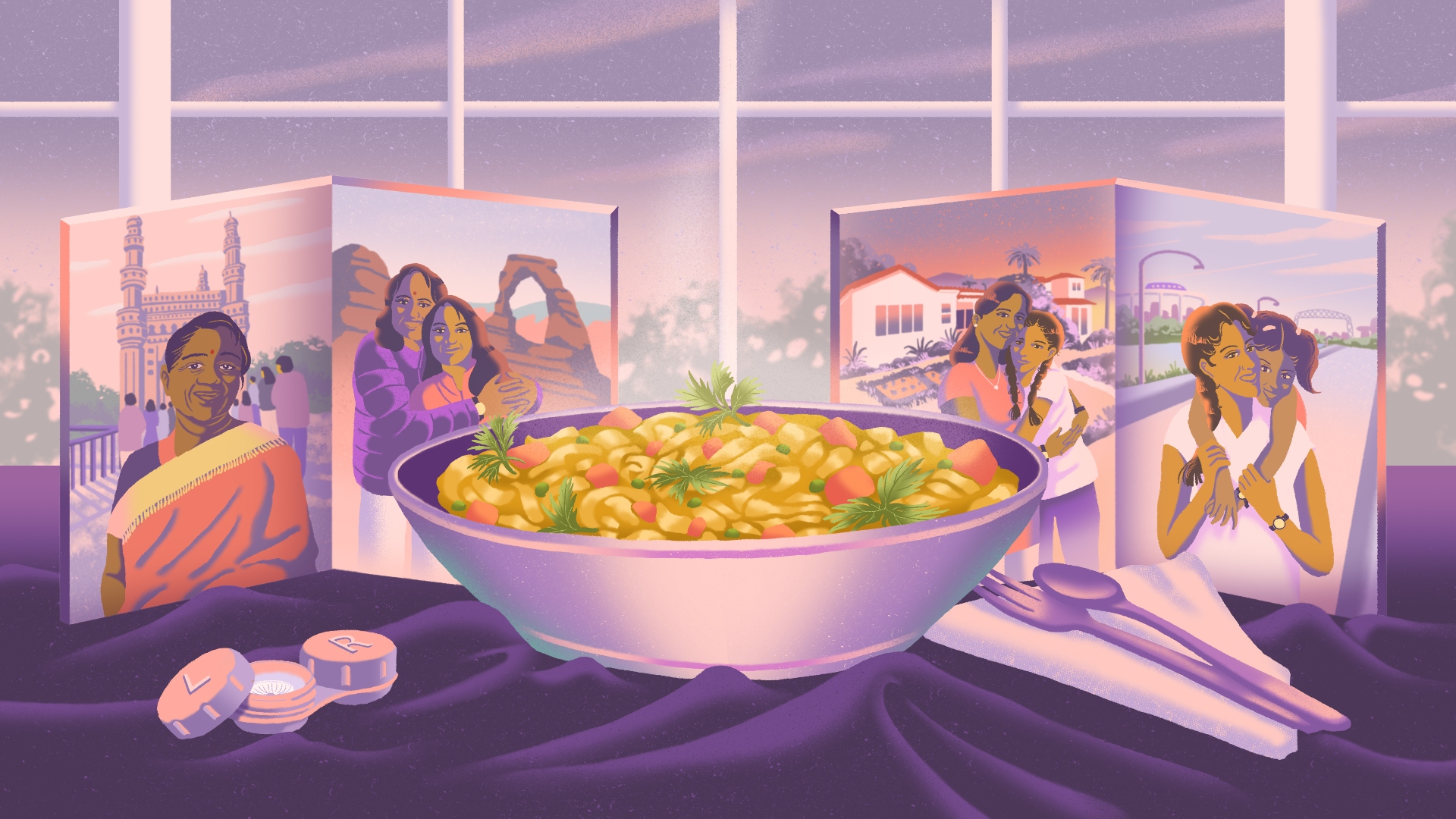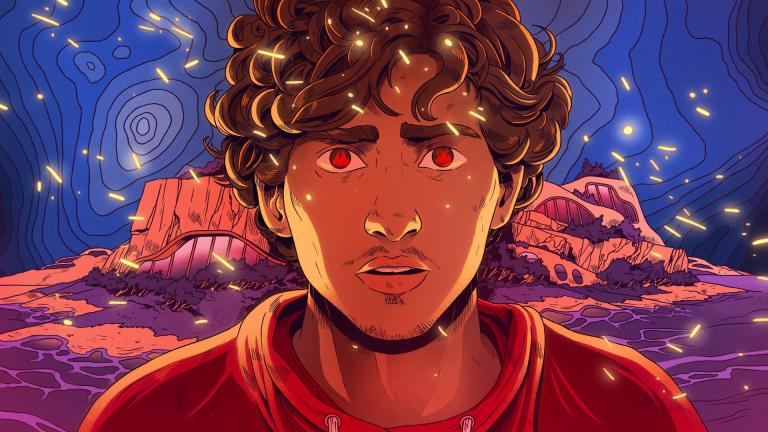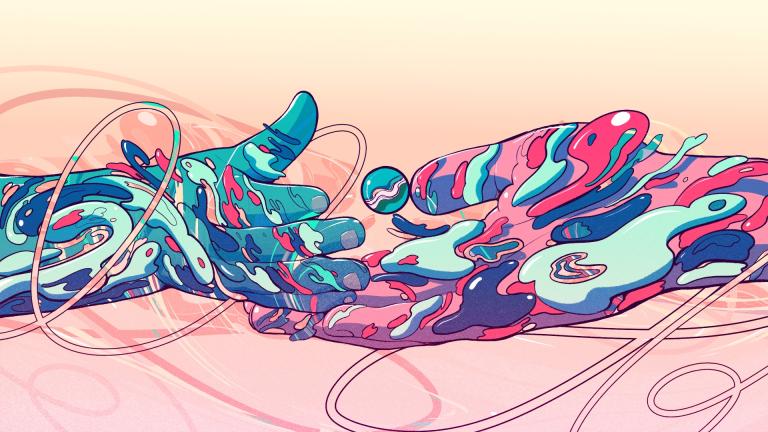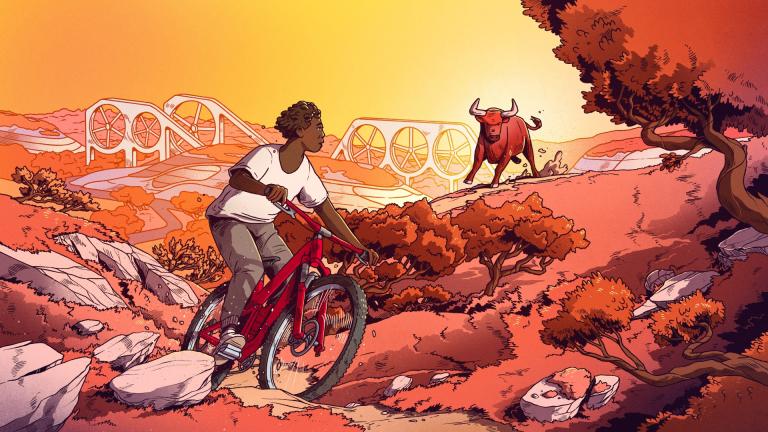Imagine 2200, Grist’s climate fiction contest, celebrates stories that offer vivid, hope-filled, diverse visions of climate progress. Discover all the 2024 winners. Or sign up for email updates to get new stories in your inbox.
Thursday, February 9, 2023
I’m bundled in a wool overcoat against the 6 a.m. winter chill of Los Angeles. The former New Yorker in me scoffs at how soft I’ve become against the cold — or rather, the “cold,” since it’s a full 50 degrees and I’m shivering. Today’s high is 80, so by noon I’ll have stripped down to a crop top. I know it’s climate change and all, but I’d be lying if I said I’m not just a tiny bit excited for a short reprieve from the monotonous months of 50-degrees-and-rainy that we’ve been having this winter.
The morning frost on my Subaru is tenacious, even after I run the engine for a little while. I’m bordering on late for kathak class, so I pull out of the driveway with icy windows and hurry to beat the rush hour traffic.
In the studio it’s a steady thrum of the tabla over the stereo system:
tha ki ta tha ki ta — gin na
tha ki ta tha ki ta — gin na
tha ki ta tha ki ta — gin na — dha
gin na — dha
gin na — dha
And then a relentlessly driving pace of chakkar, or one-count spins:
tig da dig dig ek…
do…
teen…
chaar…
paanch…
chhe…
saath…
And on and on…
After an hour of this, I’m breathless. We’ve been drilling a composition with 31 chakkar, and even after months, I’m losing my balance somewhere around 26.
I leave class and head back to my car, protein shake in hand, sweat gluing my kurta to my skin, a string of profanities running through my mind as I scold myself for tapping out at 26. I’ve just slipped into my driver’s seat when my phone rings. One peek at the screen and my mood elevates.
“Hi Amma,” I say with unrestrained fondness as my mother’s face grins back at me over FaceTime.
“Hi chinna,” she responds with equal affection. “Just finished kathak?”
“Yeah, about to head to the grocery store on my way home.”
“Shall we quickly call Ammamma before she sleeps?”
“Sure, my parking meter’s out in 10, though.”
“We can just say hi. FaceTime or Whatsapp?”
“FaceTime. Can you add her in?”
“One minute.”
After some shuffling around, a second little box populates on my screen, offering me the stray wisps of white hair otherwise known as the top of my grandmother’s head.
“Hi Ammamma,” I say.
“Hi Amma,” my mom chirps.
“Hi kanna. Bujie kanna re. Sweetie kanna,” croons my ammamma’s forehead. “How are you both?”
“Good, can you bring the phone down?” I say, holding back a laugh. “We only see the top of your head.”
Amma and I call Ammamma together every week. It used to be Sundays, like clockwork, when I was in grade school. Now it’s sort of whenever we catch each other. Every week we remind her to tilt the phone down so we can actually see her face. And every week she insists on greeting us with her forehead.

Ammamma’s puttering around her kitchen in Hyderabad, 8,711 miles away from me in California. My memory conjures up the smell of hearty palakurrapappu and fluffy idli. Chili-spiced tur dal roasting on the tava for homemade podi. The softness of her orange sari, pallu tied securely around her waist so it stays out of the way of her busy hands.
She’s lived alone in Tarnaka for almost 40 years, ever since my grandfather passed away. She’s 85 now and wobbles about her small flat with the vigor and determined independence of a 20-year-old. My amma got this from her, I think. I swear my amma will be single-handedly shoveling piles of snow as tall as she is (five whole feet) from her Park City, Utah, driveway until she’s 90 years old.
I tell Ammamma about kathak class and she glows with pride. “Very good, kanna, Very good. I’m very glad you’re keeping up with kathak. Very good.”
“I’ll show you this new composition when I next come, Ammamma.” She smiles the most when I promise this. Every year, when we visit her in India, I dance for her. In those 15 minutes while she watches, she’s filled with more childlike joy, more wonder, more freedom of spirit, than any other moment I see her. My grandma, like many women in her generation, carries a deep anxiety. Kathak transcends that, transports us together, unlocks her. Dance is hardly my profession, but it has a cemented place in my life as a psychosomatic way to stay rooted in culture and family, from half a world away. As a way of staying connected to Ammamma.
“Aim chestunavu, Amma? What are you doing?” my mom asks her mother.
“Aim ledu. Just putting away the food.”
“What did you make for dinner?”
“Nothing much,” Ammamma says. “Some pappannam, that is all. Tomorrow I’ll make some cabbage koora.” She pauses in her puttering to pick something up off the counter. “See? Do you see the cabbage?”
Ammamma adjusts the angle of the camera in an effort to show us her cabbage.
“Do you see?” But she’s pointing the camera at her ceiling, and I’m having a hard time repressing my laughter.
“No, Ammamma, we can’t see. You’re showing us the ceiling.”
Ammamma adjusts the angle again, and now we’re feasting our eyes on a sliver of her ceiling that’s been joined by a section of her wall.
“Now? Now do you see? Do you see the cabbage?”
Amma is openly laughing. “No, Ma, we don’t see the cabbage. You’re showing the wall.”
Another unsuccessful adjustment, then: “OK, now? Now do you see the cabbage? Do you see the cabbage?”
Ammamma’s excitement is only intensifying, but no appearance from any cabbage thus far. Now Amma and I are both shaking with mirth.
“Do you see it?” Ammamma continues to insist.
We don’t answer, because we’re too busy gasping for breath. Then, miraculously, we see a sliver of a blurry green leaf flash across her FaceTime camera.
“Oh!” Amma and I both shout.
“We see it, Ammamma!”
“Yes, yes, we see it, Ma.”
“You see the cabbage? You see it?”
“Yes! Yes, Ammamma, we see the cabbage!”
Now even Ammamma is laughing.
I screenshot this moment several times, never wanting to forget these small winks of diasporic joy, the three of us spread across three cities and three generations, giggling like sisters together on a sunshine summer afternoon.
It’s not long before Ammamma’s chuckles turn into coughs, peppered by a sort of rough wheezing that I learned as a child is part of her chronic asthma. My parking meter blinks red.
Tuesday, November 19, 2047
I’m in the front yard, doling out carefully measured sprinkles of water to the small garden I’ve struggled to nurture for the last several growing seasons. The water rations for victory gardens have gotten more and more economical over the last 10 years. In our little patch we still get tomatoes and kale and grow some neem, and the occasional surprise potatoes spring out from wherever we’ve last dug in compost.
The rest of our food comes from the community garden (which does better some years than others), the local co-op (which is not always well-stocked because it hasn’t quite yet reached financial stability), or with great burden to our wallets (anything requiring long-distance freight costs an arm and a leg now, partially because it’s just too expensive at a basic resource and carbon level, and partially because of the taxes they’ve been trying to institute on non-local food).
It’s been a tough transition period. Here in California, we have the farming infrastructure but not the water. In other parts of the country, land that’s been monocropped under generations of agribusiness is in various stages of transition to regenerative farming. The question of who pays for this transition, what carbon taxes get charged or credited and to whom, and who leads the proposed solutions that take the place of the old order … well, it’s been a thorny time. But it’s also a time of inspired experimentation. I remind myself of that when the overwhelm hits. I remind myself of the energy:
Where we live, in the historically Black neighborhood of Leimert Park, our family’s borne witness and supported as those who’ve been holding it down here for generations lead the charge on collective care. Community gardens, co-ops, free fridges, heat shelters, communal front-yard victory gardens, shade-tree planting, seed saving, after-school programs, “Buy Nothing” gift economy groups, car shares, and so much more.
Funding is a constant issue for these initiatives (right now the biggest source of funding is private donors, but the community is keenly problem-solving for a self-sufficient model). Everything’s decided at our monthly town hall meetings, which are always lively and full of opinions. There’s a small group of us South Asians in the neighborhood, and our agreed-upon job at these meetings is mostly to listen well and provide the chai.

Out in the garden, dusk is dancing vividly before me, blues chasing pinks chasing oranges across the hazy horizon. I always stop to cherish it, never knowing how many more I’ll savor before the smog swallows up color altogether.
I pause over the far end of the garden, which has been exceptionally dry no matter how much I try to feed it. It’s honestly a little embarrassing. My neighbors’ victory gardens look far more luscious than mine. The community decided at one of our first meetings years ago that victory gardens would go in the front yard (communal, conversational, open, and engaging) rather than in the backyard (hidden, private, inaccessible). 99 percent of the time, I love that we made this decision. The 1 percent is just the occasional despair I feel when I remember that my garden is on display and not in the best shape, and my ego gets to me. I make a mental note to hop next door tomorrow to Amrit and Hari’s to ask Hari what cover crops are working in his yard these days — his green thumb has always guided mine, and maybe he’ll know how to better nourish this dry patch.
From somewhere inside the house, my phone rings.
“Amma!” Gita’s voice calls to me. “It’s Ammamma.”
Her 5-foot frame, identical to mine, comes bounding through the open screen door, my phone in her hand.
Gita’s hair is curly like mine, and I fucking love that about her. She’s smart as a whip, and I love that even more about her. Sometimes I look at her and marvel at the fact that I made that creature. Now I understand what my amma’s always saying about “having a kid is like putting your heart outside of yourself and watching it walk around,” or some shit like that. Sometimes I want to gather Gita up and store her safely back inside my body.
She comes over to me and scoops me into an affectionate hug before setting the phone up flat on the porch table and hitting “answer.” We both activate the bracelets on our wrists. Almost immediately a spark of light projects upwards from the Beam projection port on my phone, and a three-dimensional hologram of my mother takes shape from the light.
“Hi Amma,” I say.
“Hi Ammamma!” Gita says brightly.
“Hello? Hello?” my mom says. “I can’t see you.”
No matter how many times we do this, she always comes in perplexed at the beginning of a Beam call.
“Amma, did you put it face down on the table again?”
“Allari pilla! Troublemaker. I kept it properly face up, I’m not that technologically challenged. But still I don’t see you?”
“Did you turn the brightness back up or is it in night mode?”
“Oh. One minute. How do I do that again?”
“There’s a control on your bracelet. This is why I was saying you should just leave it on the automatic setting.”
“I can figure it out. I don’t like how bright it is on auto, it makes my eyes burn.”
We watch her hologram-self fidget with something off-camera, before lighting up in delight.
“Got it!” she says. “Hi! Oh, Gitu, you’re looking so nice. Are you going somewhere?”
“Thanks, Ammamma,” Gita says. “I was invited to a prayer circle tonight, in preparation for the burns next week. Elena is leading, and she told me I could bring some jasmine and haldi and chandan as offerings from our family.”
For the past few years, Gita’s been volunteering with the Tongva Conservancy’s ceremonial burns, covering any responsibilities she’s invited to participate in. Fire season has worsened over the last 10 years in California, so many regions, including L.A. County, realized survival depended on working with local tribes to revive cultural burning practices. The prescribed burns that Indigenous folks across the world have practiced culturally since time immemorial kept rampant dry brush under control and created a cycle of nourishment for the forests, until colonialism outlawed the practice. In L.A., the late fall burning they’ve restarted allows for plant life to rejuvenate in the rainy winter season, the goal being to once again transform dry underbrush into verdant vegetation come spring.
“How are you going there?” my amma asks Gita. “I thought your driving permits are Monday, Wednesday, Saturday?”
“Elena got a Tuesday slot in the community car share, so she’s coming to pick me up. I think she got one of those Rivian two-doors!”
“Fancy,” I say.
Gita goes inside to start gathering her things while I ask Amma what she’s up to.
“Not much,” Amma replies. “Just making your Ammamma’s cabbage koora.”
“Tease!” I accuse.
“I sent you seeds last year!” Amma says defensively.
“Yeah, yeah, but they don’t grow, I told you. The water they need is way beyond our rations.”
We bicker warmly about cabbage koora — a nostalgic but water-intensive vegetable I probably haven’t eaten in 15 years at this point. As the cool night air sets in, Amma’s hologram shines brightly above the porch table. A few stray moths, confused, start circling in the vicinity. I watch their wings disturb the pixels here and there.
When Elena’s car (indeed a Rivian two-door) pulls up, Gita flashes by me with a kiss and hops in, leaving the divine aroma of jasmine and chandan in her wake. At the same moment, a second set of footsteps tip-tap up the stairs from the street into our garden, and I’m engulfed in a familiar embrace.
“Hi buddy!” a voice coos at me. It’s Aditi, close friend and co-conspirator. She plops her bike helmet and backpack onto a chair on our porch. Seeing that my mom’s on Beam on the table, she grins. “Hi Aunty!” She hits the “join” button on her Beam bracelet so that my mom can see her hologram, then sprawls out in the grass beside me. “How are you?”
“Hi, Aditi! Good, good. How are you, how’s Noor?”
“They’re good, they’re still at the courthouse, or they would’ve come by with me.” Then Aditi nods at her backpack and looks at me conspiratorially. “I went to the Indian store today.”
I let out a whoop. This is a luxury we reserve only for special occasions. “Shut up. What’re we celebrating?”
“Wellll, Noor Beamed me from the courthouse today and told me that our permit request for the collective is next in line for consideration. And that they think we’re a sure thing.”
Amma’s hologram gasps. “The housing collective?”
“The one and only!” Aditi says.
That night, with Amma still on Beam, Aditi pulls out fresh guavas and late-season mangoes, a rare pleasure all the way from the subcontinent, and we twirl around…
tha ki ta tha ki ta — gin na
tha ki ta tha ki ta — gin na
…between bites of home.
Friday, July 9, 2077
I eye the box on my coffee table with suspicion. Gita’s had some strange contraption called Iris delivered to me, and she swears it’s worth whatever trouble it surely brings. I asked Aditi and Noor about it, and they agreed that the concept of sticking digital contact lenses in one’s eyes is unpleasant, to say the least. Gita instructed me to be open to it and threatened to call me an old codger if I refuse to even try it out.
“Iris makes your eye a projector, Amma, your eye. Can you believe it? It’ll be like Reyna and I are there with you, 3D, walking and talking and interacting with you and your space. Like we’re literally there,” she’d said when we last talked.
The idea of feeling like my daughter and granddaughter are physically with me ultimately makes Iris an easy sell, despite my hesitations. Remembering her words, I decide to open the damn box.
After great difficulty and no small amount of grumbling, I’ve finally affixed the small translucent contacts to my eyes, and, scrutinizing the user manual, I figure out how to power on this incredibly invasive piece of technology. I’ve had it on for less than two minutes when the accompanying earbud headphones inform me that I have an incoming call. It is, of course, Gita.
“Amma!” she shouts joyfully. “You did it! You finally listened to me! This is so cool.”
I’m not sure exactly what is so cool, as my vision is blurry and I’m completely baffled by how she could possibly be seeing me right now. But I take her word for it. Gita does some troubleshooting that I don’t understand, laughs at me quite a few times for being a bumbling fool with this new device, and finally coaches me through getting the focus in the lenses calibrated.
And then I see what’s so cool. Gita has set it so that the simulated world we’re in is my real front yard. I’m really here, right here, right now, lying in the grass. And it looks like they’re here, too, as full-scale renderings of their real selves. They can interact with me, with my garden. On their end, Gita tells me, it’s like being in virtual reality. She tells me that next time, we’ll make the setting her house, where she and Reyna can move around in the real world and I’ll be visiting via virtual reality. Once I’ve quit my grumblings, we settle into our regular pattern of conversation — what we’re all eating, how everyone’s love interests are, whether we’re taking care of our health — except it is quite cool, because the whole time it’s like Gita and Reyna are lounging in the yard with me. I tell them this reminds me of way back when I was a kid in India, loitering outside all afternoon with my cousins.
“You used to go to India every year, Ammamma?” Reyna asks me, eyes wide.
“Every year. We were very lucky.”
“Do you think you’ll ever go back?”
“With the flight restrictions, it’s almost impossible,” I say. “Now I think it’d take me three trains and a whole-ass ship. No, I don’t think I’ll ever be able to go back. But sometime in the future … I think you will.”
My girls both reach out to me as glittering pixels in the golden summer afternoon. I like how realistically Iris portrays them, truly as if they’re here in the grass with me, just like Gita promised, reaching towards me to comfort me. But the technology misses what I love most about them: their smell, the warmth of their skin, the calm in my own heart when I’m in their physical presence.

When Gita told me she and her partner Gloria had decided to move away from L.A. to raise Reyna somewhere that was more climate-stable, I understood. My mother left her mother in India to come to America in search of a better life, an economically stable life, a life that would offer the opportunity of abundance for us — for me — after the literal and metaphorical scarcity that British colonialism imposed on the subcontinent. At the time, who would’ve thought that decades later, rampant consumption and capitalism would finally deliver that same scarcity here to our doorsteps in America?
Then I moved away from my mother, starting a life in L.A. in community with other South Asian storytellers who were committed to drawing attention to climate and culture. Those of us who’d joined the movement as soon as we became conscious of it saw the writing on the wall long back, but it took the bubble actually popping around the wealthy for those in power to take any real action on what was going on.
In L.A., most of the mansions in the hills got wiped out by fires long ago. A staccato of winter storms caused irreparable mudslides along Mulholland Drive. The Pacific Ocean claimed Santa Monica. The city was forced to implement retreat strategies, which led to them regulating lot sizes as more people had to relocate to the livable areas of L.A. Predictably, some millionaires really fought against this and did everything they could to rebuild their mansions and add “climate-protective measures,” but no one ever got too far in the process because insurance companies no longer cover houses built in long-designated Hazard Zones, and after a certain point with all the carbon taxes levied on any building project that exceeds Reciprocal Resourcing Standards, the mansions were no longer financially viable. Other millionaires were shockingly supportive of the lot size restrictions, and wound up working within Reciprocal Resourcing Standards to build sustainable collectives.
Of course, some people still went the route of save-myself-at-the-expense-of-others. They built bunkers with the goal of “self-sufficiency.” It’s a seductive idea, until you realize what it means is isolation from any sense of community. We are by definition interdependent. Our survival is predicated on our ability to work together. But I’m pretty sure Elon Musk’s kids are still raising their families all alone in their secluded fortress. Their only outside interaction is probably with the drones that deliver their caviar.
Ultimately, it was the local resilience, the grassroots ideas, the place-based knowledge that allowed us to survive. These days, I live at Aunty Gang Collective (the name was inspired by Gita always calling me and my cherished group of South Asian women friends “aunty gang”). Here, there’s no caviar (never understood the appeal, anyway), but there’s music in the streets every day.
tha ki ta tha ki ta — gin na
After weathering a long waitlist at the permitting office, our little collective of 15 homes was finally greenlit and built with reclaimed and organic material as part of a government-sponsored hyper-localization effort. Over the last 30 years, L.A. was essentially renovated and rewilded by a team of what we would’ve called environmental architects back when I was growing up (today we just call them “architects”), led by a group of Indigenous engineers and designers.
We can’t drive much anymore (even electric cars, which over time proved to be too resource-intensive to continue manufacturing at scale), but it’s OK, because the electric buses and trains are much more connected than they used to be. Plus, Aditi and Noor are original Aunty Gang members and live just down the street. We hobble over to each other’s houses almost every day.

“OK, so India’s off the table,” Gita says, cutting off my thoughts, “but more realistically, can you come here, Amma? I told you, Gloria and I can arrange for the flight permits — we have so many credits from volunteer days with the ceremonial burning crews. The aunty gang can help you pack up, and you can be here by next week.”
I make a face at her. I hope with Iris that she can properly see the extent of my disdain for this idea.
“Not this again, kanna.” I stick her with an exaggerated eye roll. “Every call, the same thing: ‘Amma, now that Dad has passed what’s left for you in L.A.? You’re allllll alooone, why don’t you leave everything you’ve known for the last 60 years and come here to fucking Duluth, Minnesota, to join us in this commune of white people.’ Chhi!”
“Well, it was either this or Vermont,” Gita quips back. “And it’s not called Duluth anymore. It’s Onigamiinsing — it’s Ojibwe. Anyway, please just think about it.”
“I’ll think about it,” I lie.
“You say that every time, but you never really do.”
“And yet you keep asking.”
“I worry about you.”
“And I worry about you, kanna.”
“About me? I have Glo and Reyna. I don’t like you being alone over there, you’re 82, and that’s not young.”
“OK, first of all, rude. Second of all, I’m not alone! I have Aunty Gang, all my friends within walking distance. The Collective has grown a lot since you last visited. It’s like a mini Wakanda here now. But with less beautiful superheroes and more elderly people.”
“Waka-what?”
“Never mind, it’s before your time. How’s kathak class, Reyna?” I change the subject swiftly.
“Oh. Good!” Reyna says. “We’re working on chakkar. I’m up to 31 in a row! I can Iris you from our studio next time and show you, Ammamma. It’ll be like you’re watching me dance in person.”
The thought fills me with pride. With longing. With wonder at the fact that so many generations, so many geographic locations and climate-related disruptions later, we preserve this art purely because it makes us happy.
“That would be lovely, kanna.” I pause. “Actually, I wanted to show you something.” I take a few steps over to my left. “Can you see?”
“See what? You’ll have to be more specific, Amma,” Gita says.
I point. “OK, do you see this?” I’m gesturing to the front left corner of my garden, the dry section that insisted on following me from Leimert Park to Aunty Gang Co. The dry section where years ago I’d planted some cabbage seeds my mother had given me, though they’d never grown. The dry section that now was —
“I don’t see where you’re pointing, Amma,” Gita says. “It must be out of scope. Let’s expand range on your Iris.”
I fidget with the control she directs me toward.
“OK, did it work?” I ask. “Can you see?”
Gita stifles a laugh and Reyna openly giggles. “No, Amma. I think you narrowed the scope.”
“Oh. What do you see?”
“Your foot.”
“Oops,” I say. I try again, but the touchy control is so minimalist that I can’t tell where on the range scale I am. “How about now? Now can you see it?”
“No, Ammamma,” Reyna laughs. “Now we see your left big toe. In precise detail.”
I mumble some R-rated expletives under my breath. “But I can see you. How am I supposed to know what you’re seeing? I told you I wouldn’t like this Iris thing.”
“OK, let’s stay calm,” Gita says, still chuckling. She talks me through the bewildering device and finally the formerly very dry patch of my garden is evidently in view, because —
“Is that cabbage?” Gita exclaims in shock.
“Yes!” I exclaim right back. “It’s cabbage! Cabbage!” I let out a loud hooray.
“OK, OK, we see it,” Gita laughs. “We see the cabbage.”
“Reyna, choodu! Look!” I say. “Baby cabbages!”
Reyna looks perplexed at my joy. “Very cool, Ammamma …”
Personally, I don’t think either of them get the hype at all, so I try again. “These haven’t grown here since I was around your age, Gita. My ammamma used to make cabbage koora all the time. And to think Reyna’s never even seen one!”
“What? I see them all the time,” Reyna protests. “Amma made cabbage koora last week!”
“Yes, kanna,” I say, “but that’s that hydroponic shit you people grow over there. The real stuff is grown in the dirt. Real soil. Real food.”
“OK, Amma, let’s not get into this again,” Gita says, clearly miffed. “Hydroponics have fed a lot of people over the last 50 years. But I’m very happy for you about your cabbages. You can Iris us once they ripen, and we can make cabbage koora together. Reyna and I with our ‘hydroponic shit’ and you with your ‘of-the-dirt’ stuff.”
We dream for a while together about cabbage koora, until Gita declares that it’s bedtime for them over on Ojibwe Land.
I disconnect from Iris and allow the shimmering afternoon to envelop me. I slip my shoes off and dig my feet into moist soil. I feel my pulse.
tha ki ta tha ki ta — gin na
tha ki ta tha ki ta — gin na
My back hurts more often these days, and the asthma’s been back for nearly 20 years (one can’t blame my lungs — they put up a heroic fight against nearly half a century of summer wildfire smoke). I’ve had my share of cancer scares, too, like the rest of us.
tha ki ta tha ki ta — gin na
I think of the two generations before me, who saw the world change so much in their own lifetimes: my ammamma watching India gain independence from the British Raj, and my amma, moving to a completely different continent and building a new life from scratch.
I think of the two generations after me: Gita, who didn’t see stars for the first three decades of her life until regulations helped clear the smog. Reyna, who’s never seen the snow but can do 31 chakkars and accompanies her mom to volunteer for ceremonial burn support.
tha ki ta tha ki ta — gin na
I think of the descendants that follow, from whom I borrow this earth.
And in the cabbage patch, loam between my toes,
tha ki ta tha ki ta — gin na — dha.
— gin na — dha.
— gin na — dha.
I dance.
Sanjana Sekhar (she/her) is a socioecological storyteller amplifying character-driven stories that help heal our human relationships to ourselves, each other, and our planet. As a writer, creative producer, and film director, her work has been featured in the Hollywood Climate Summit, Tedx Climate Across the Americas, VH1 India, Sage Magazine, and the Webby Honorees. She is currently based in Los Angeles on Tongva homelands.
Mikyung Lee (she/her) is an illustrator and animator in Seoul, South Korea. Her poetic and emotional visual essays focus on the relationships between people and objects, situations, and space.
